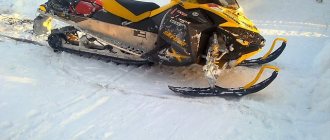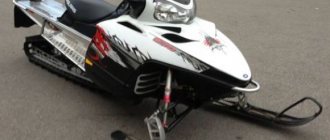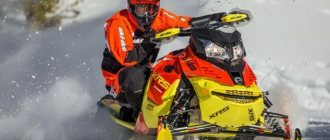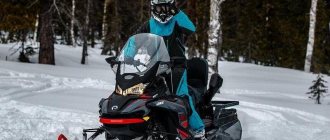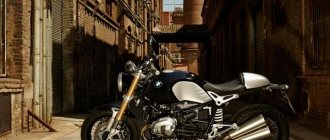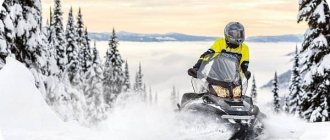BRP Ski-Doo sport snowmobiles:
- Sci-doo MX Z X-RS 600HO E-TEC
No reviews
- Ski-Doo MX ZX 4-TEC 1200
No reviews
- Ski-Doo MX ZX 800R Renegade PTEK
No reviews
- Ski-Doo MX Z X-RS 800R E-TEC
No reviews
- Ski-Doo MXZ X-RS 850/600R E-TEC
No reviews
- Ski-Doo MXZ XRS 800 E-tec
No reviews
- Ski-Doo Renegade Backcountry-X 800R E-TEC
No reviews
- Ski-Doo RENEGADE X-RS 850 E-TEC
No reviews
- Ski-Doo RENEGADE X-RS 900 ACE TURBO 137”
No reviews
Video
The snowmobile is equipped with the revolutionary tMotion rear suspension: thanks to a new linkage design and articulation, the lower part is capable of tilting two degrees to one side or the other in the horizontal direction. That is, when maneuvering, the tilt of the snowmobile itself is complemented by a lateral rotation/displacement of the suspension. Also, to ensure the required degree of freedom of the specially designed Powder Max II track with a lug height of 63 mm, the “slides” and support rollers were shifted from its edges to the center. This was done so that the edge of the track, which is not equipped with stiffeners (Flex-Edge technology), could bend freely when the snowmobile tilts.
With a track width of 410 mm, the length of the transverse stiffening ribs is only 310 mm (whereas in conventional tracks these ribs run across the entire width). Because of this, a deformable zone 50 mm wide remains at each edge of the track. This allows the snowmobile to maneuver with the ease of a “narrow-track” vehicle, while maintaining all the advantages of a wide track - both in deep snow and on compacted trails. The front suspension is built on traditional double A-arms with HPG Plus shock absorbers with 200 mm of travel.
The ski track is adjustable within 907950 mm. For ease of movement along steep mountain slopes, special teeth are installed on the upper lever, which prevent the foot from slipping at the most inopportune moment.
Ski-Doo Summit SP 600HO E-TEC 154 – TEST
2014 onwards, 594.4 cm3, 120 l. s, 206 kg, 529,000 rub.
text: Yuri Solonovich photo: Roman Romanishin
in the photo: Yuri Solonovich
>>After the collapse of the Soviet Union, the development of technical sports in our country almost completely stalled. The meager funding of DOSAAF structures led to oblivion and the total disappearance of sports motorcycle and auto clubs, and even today, in the age of active and profitable trade in hydrocarbons, the situation in this area, unfortunately, remains virtually unchanged. The most unpleasant thing is that during this forced post-perestroika downtime, we have practically lost the main thing - the culture of educating our younger generation.
After all, it was in the Soviet semi-basement sections and workshop circles that the first rules of existence in human society were laid into the fragile and not yet intoxicated brain lobes of young technology lovers, instilled in the skills of handling working tools and passed on invaluable experience in the operation and repair of two- and four-wheeled equipment. Here, in the oily walls that smelled of gasoline and 2-stroke exhaust, the first worldly and not-so-wisdom was conveyed to the young blockheads, which in our time, unfortunately, not many people remember. For example, people have completely forgotten that when dealing with powerful sports equipment, you should always go from small to large, from a small rental kart to a Group A rally car, from a 50 cc two-stroke to an adult motocross motorcycle. It is precisely because of this “forgetfulness” that today “liter” sports bikes, 450 cc cross-country equipment and snowmobiles equipped with engines of maximum volume and power are especially honored...
The widespread development of mountain snowmobiling has led to the emergence of a completely new class of machines. Powerful and lightweight, equipped with long tracks and serious 2-stroke power plants. But, as it turned out, the use of such technology is justified only in a few cases: in the mountains, the slopes of which are covered with really deep snow (for such conditions, it would be nice to equip the snowmobile engine with a turbine or supercharger...), or when the rider has good theoretical and physical training. After all, not everyone needs the exorbitant performance characteristics of an “adult” mountain biker! For example, the use of a powerful snowmobile in low-snow areas of the Central region of Russia is generally not very justified... Or consider the case when a future star of the slopes (especially if it is a child or a woman) has just begun to master snowmobile technology. It is in these situations that the power of the 800cc 2-stroke engine will hinder rather than help the novice rider. This is where the entry-level “mountain bike” comes into the arena - the Ski-Doo Summit SP 600HO E-TEC 154. The “Baby Summit”, like its “big brother”, is built on the REV-XM platform. The rigid, lightweight chassis features double wishbone front suspension with HPG high-pressure gas shock absorbers and 200mm travel. The ski base is adjustable in the range of 1025–1080 mm, and it should be noted that this value is significantly greater than that of the “older” 800 cc model. This was done, most likely, for additional stability of the snowmobile, because if on the Summit 800, rolliness and excessive tipping are, rather, a blessing, then the younger model, for the sake of its use by beginners, was forced to “stand firmly on its feet.”
The snowmobile is equipped with New Pilot DS skis with a special skate in the middle. Their peculiarity is that on hard surfaces the device stands exclusively on this ledge and, due to the small support area, it is quite easy to steer. But when driving into deep snow, the contact patch increases significantly, which has a positive effect on the cross-country ability of a snow machine. Also installed in the front suspension is a stabilizer bar that can be switched off using the Quick Disconnect system; by removing or installing it and “playing” with the settings of the front shock absorbers, you can seriously change the behavior of the Summit SP 600HO over a wide range. Despite its status as the “junior” model in the Summit mountain family, the rear of the chassis features BRP’s top-of-the-line t-Motion suspension, which gives the snowmobile’s track an additional degree of lateral freedom. Additionally, the Summit 600 features Ski-Doo's PowderMax track with FlexEdge technology. Its peculiarity is that the edges of the 406 mm wide track are flexible, while the main body of the track is reinforced with fiberglass reinforcing bars that strengthen its 300 mm wide central part. The remaining “soft” edges of the track can be additionally bent when driving on a slope. The PowderMax lug height is 57.2 mm (versus 63 mm for the 800 cc “big brother”). Thus, t-Motion and FlexEdge allow even the most inexperienced rider to lean the snowmobile on a slope.
But the main difference between the “junior” model is, of course, the engine: the snowmobile is equipped with a 2-cylinder 2-stroke Rotax power plant with a displacement of only 594.4 cm3 and liquid cooling. Thanks to the use of E-Tec technology, fuel under enormous pressure is injected directly into the combustion chamber, which is designed in such a way that layer-by-layer and uniform combustion of the fuel-air mixture occurs. And this allows you to make the snowmobile more economical without having to sacrifice engine performance. The Ski-Doo Summit SP 600HO powerplant develops only 120 hp. s., which is significantly less than on the Summit 800. However, despite such a modest “horsepower”, the long-stroke engine is quite powerful. So why did such a seemingly controversial snowmobile appear in the BRP lineup? After all, the weight of the Summit SP 600HO is only a few kilograms less than that of the 800 cc model, and the engine is significantly weaker... If you think about it, the difference in price is not so huge - only about 60,000 rubles. Why buy a “younger” model if you can immediately buy an “adult” projectile for uncompromising boondocking? Having tested the Summit SP 600HO in the vicinity of Murmansk and the Khibiny mountain range, I seem to know the answer to this question. Thanks to the latest technologies, a progressive platform, New Pilot DS skis, t-Motion suspension and PowderMax track, the snowmobile, traditionally for the new Summits, handles well and rolls perfectly on its side on almost any slope. And, unlike competitors such as the M-Series from Arctic Cat or the RMK family from Polaris, the rider has to put in significantly less effort to do this. I think hardly anyone would argue that the new “mountain bikes” from Ski-Doo are much more forgiving of control errors than snowmobiles from other manufacturers. Add to this the power plant, which has a more friendly character compared to the 800 E-Tec - and you understand the beauty of this snowmobile!
Driving in very deep snow? Please! The flexible motor allows you to open the gas fully and at the same time not cut through the snow with the caterpillar right to the center of the Earth! To drive a “traverse” along a slope of almost any complexity, without having the skills to hold a powerful car on a straight path? You can also try! T-Motion and Flex Edge are here to help! So in the end, we get an almost ideal piece of equipment for beginning mountain snowmobilers, their wives, girlfriends and children - especially those who live in low-snow regions of our country. For getting your first boondocking and mountain riding skills, the Summit SP 600HO is almost the perfect option. Well, if progress in skating becomes clearly noticeable and you simply no longer have enough engine power, then you can always exchange the “Baby Summit” for its larger relative. Fortunately, the high liquidity of used Ski-Doo equipment will allow you to do this with ease. /
